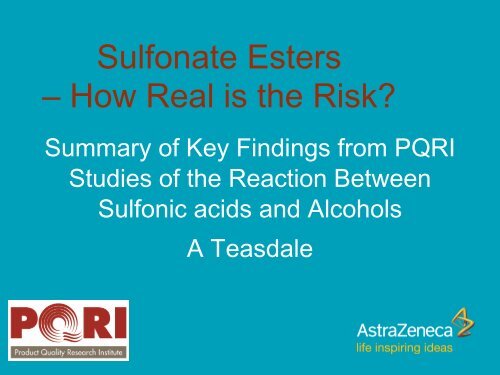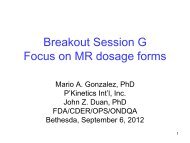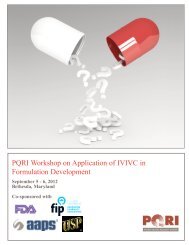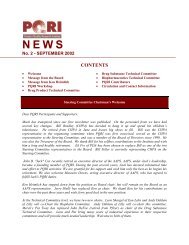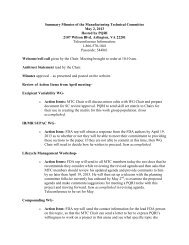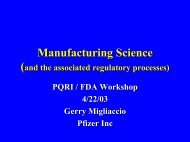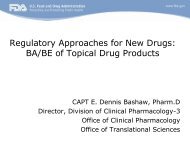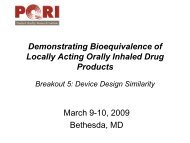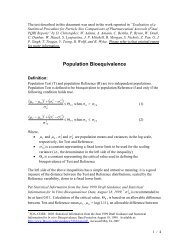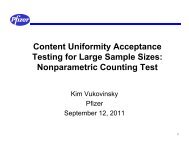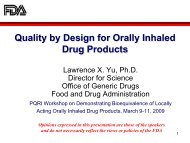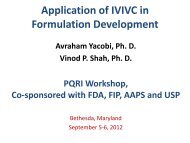Sulphonate Esters - How real is the risk? - PQRI
Sulphonate Esters - How real is the risk? - PQRI
Sulphonate Esters - How real is the risk? - PQRI
Create successful ePaper yourself
Turn your PDF publications into a flip-book with our unique Google optimized e-Paper software.
Sulfonate <strong>Esters</strong><br />
– <strong>How</strong> Real <strong>is</strong> <strong>the</strong> R<strong>is</strong>k?<br />
Summary of Key Findings from <strong>PQRI</strong><br />
Studies of <strong>the</strong> Reaction Between<br />
Sulfonic acids and Alcohols<br />
A Teasdale
Global Process R&D<br />
Introduction – Description of <strong>the</strong> <strong>is</strong>sue<br />
‣There have been growing concerns expressed by<br />
regulators in relation to <strong>the</strong> potential generation of<br />
genotoxic impurities as a result of interactions between<br />
strong acids and alcohols.<br />
‣Th<strong>is</strong> has centred primarily on sulfonate esters, <strong>the</strong>oretical<br />
impurities resulting from interaction between sulfonic<br />
acids and alcohols.<br />
R<br />
O<br />
S<br />
O<br />
+ +<br />
OH R' OH R S<br />
O<br />
O<br />
OR' OH 2<br />
R - alkyl / aryl<br />
R'- alkyl - methyl / ethyl / <strong>is</strong>opropyl etc.
Global Process R&D<br />
Introduction – Description of <strong>the</strong> Issue<br />
‣Issue was d<strong>is</strong>cussed at length at <strong>the</strong> DIA meeting on genotoxic<br />
impurities – November 2005<br />
– FDA expressed significant concerns over use of sulfonic acids as<br />
counterions.<br />
‣It was clear at <strong>the</strong> meeting that many companies had carried out in<br />
house studies<br />
– Showing some understanding of levels formed and how to control <strong>the</strong>m.<br />
‣Clear challenge from th<strong>is</strong> meeting going forward was for industry to<br />
build on <strong>the</strong>se studies<br />
– To provide clear evidence of th<strong>is</strong> understanding and to publ<strong>is</strong>h.<br />
– <strong>PQRI</strong> Initiative borne out of th<strong>is</strong> need.
Global Process R&D<br />
What <strong>is</strong> <strong>PQRI</strong> (www.pqri.org)?<br />
The Product Quality Research Institute www.pqri.org<br />
‣“… (<strong>PQRI</strong>) <strong>is</strong> a collaborative process involving FDA’s Center for Drug<br />
Evaluation and Research (CDER), Industry, and Academia.”<br />
‣“The m<strong>is</strong>sion of <strong>PQRI</strong> <strong>is</strong> to conduct research to generate specific<br />
scientific information that should be submitted in a regulatory filing to<br />
CDER.”<br />
‣“…<strong>PQRI</strong> tackles projects to ensure <strong>the</strong> quality, safety and<br />
performance of drug products.”
Global Process R&D<br />
Study Model<br />
‣Key aspect of <strong>the</strong> work was independent verification<br />
of data.<br />
–Specific challenge from FDA.<br />
‣Resource also a key factor.<br />
–Real <strong>is</strong>sue for many <strong>PQRI</strong> activities.<br />
‣Also required <strong>the</strong> right skill set<br />
–Proven track record on trace analys<strong>is</strong> and of solving<br />
complex problems
Global Process R&D<br />
Aims<br />
‣To provide a sound scientific understanding of <strong>the</strong> formation and<br />
decomposition of sulfonate esters,<br />
– under syn<strong>the</strong>tically relevant conditions.<br />
‣To understand <strong>the</strong> absolute levels of such impurities that can form<br />
under process-related conditions.<br />
– Optimal process conditions to minimize <strong>the</strong> sulfonate ester formation.<br />
– Effective purge processes.<br />
‣To place reputable, peer-reviewed science-based knowledge into <strong>the</strong><br />
public domain<br />
– Methodologies for analyses and kinetic studies<br />
– Teaching with regard process design to obviate/minim<strong>is</strong>e ester formation
Global Process R&D<br />
Experimental Protocol<br />
Step 1: Investigation / Establ<strong>is</strong>hment of Analytical Methodology +<br />
Experimental Protocol<br />
1. Establ<strong>is</strong>hment of actual technique<br />
• Wide dynamic range required (low to several thousand ppm)<br />
2. Validation of analytical methodology<br />
3. Study Methodology<br />
‣ Establ<strong>is</strong>hment of a robust reaction study protocol<br />
• equipment and sampling (+ derivat<strong>is</strong>ation) procedures<br />
• Definition of <strong>the</strong> numbers of samples and frequency of sampling<br />
required for kinetic modelling.
Global Process R&D<br />
Validation Data for analytical procedure<br />
Key Data:<br />
Linearity: Linear over <strong>the</strong> range 5 –500 ug/ml EMS (R 2<br />
>0.999).<br />
Prec<strong>is</strong>ion:<br />
RSD for EMS (as Et-TPFB derivative) measured relative to <strong>the</strong><br />
internal standard 2 (d5-Et-TPFB) was:<br />
– 3 % at 5 μg level and better than 1 % at <strong>the</strong> 50 μg level.<br />
Limit of Detection: 0.5μg/ml<br />
Limit of Quantification: 1 μg/mL, corresponding to 0.001 %<br />
conversion.
Global Process R&D<br />
Analytical Procedure Based upon PFTP<br />
Derivatization<br />
O<br />
CH 3 S<br />
O<br />
OH + EtOH<br />
K. Jacq, et al J.Pharm.<br />
Biomed.<br />
Anal, O 2008, 48(5), 1339<br />
CH 3 S<br />
O<br />
OEt + H 2 0<br />
1) Samples withdrawn over<br />
time and treated with:<br />
F<br />
F<br />
F<br />
F<br />
S - Na + +<br />
F<br />
NaOH<br />
2) Samples spiked<br />
with small amount of<br />
d5 EMS:<br />
O<br />
CH 3 S<br />
O<br />
OCD 2 CD 3<br />
3) samples heated for period of<br />
time (15 min at 105 deg C in<br />
publ<strong>is</strong>hed method) to effect<br />
derivatization and insure<br />
equilibration within <strong>the</strong><br />
Headspace prior to assay<br />
4) Levels of Et PFTB and d5Et PFTB<br />
(internal standard) analyzed by GC/MS:<br />
F<br />
F<br />
F<br />
F<br />
SCH 2 CH 3<br />
F<br />
F<br />
F<br />
F<br />
F<br />
SCD 2 CD 3<br />
F<br />
Concentration<br />
values vs time<br />
based upon ratio<br />
of Et PFTP to<br />
d5Et PFTP area<br />
counts<br />
Et PFTB<br />
d5Et PFTB
Global Process R&D<br />
Experimental Protocol<br />
Step 2: Reaction Space Studies<br />
1. Definition of Scope –Sulfonate <strong>Esters</strong><br />
‣Commonly used 1 and 2 alcohols in combination <strong>the</strong><br />
2 most common sulfonic acids in terms of marketed<br />
salts<br />
–The methyl, ethyl and <strong>is</strong>opropyl esters of Methanesulfonic acid<br />
–The methyl, ethyl and <strong>is</strong>opropyl esters of Toluenesulfonic acid.<br />
‣Initially study Ethanol-Methanesulfonic acid system<br />
• Followed by focused studies on o<strong>the</strong>r systems
Global Process R&D<br />
Experimental Protocol<br />
Step 2: Reaction Space Studies<br />
2. Scope driven by common process conditions…<br />
‣Presence / absence of water<br />
‣Temperature<br />
‣Time<br />
‣Acidity<br />
• ‘parent system’ (no added base)<br />
• excesses and deficiencies of added base<br />
o Hunigs Base & Pyridines as models for API<br />
• 2,6-lutidine used, as sulfonate salts are highly soluble<br />
• weaker base than many pharmaceutical bases, <strong>the</strong>refore<br />
• protonated base <strong>is</strong> stronger acid than pharmaceutical<br />
salts…
Global Process R&D<br />
Reaction mechan<strong>is</strong>m – Ester Formation<br />
‣Reactions of (O 18 ) labelled methanol with MSA were analysed by CG-MS.<br />
O<br />
R2 S O-H<br />
O<br />
+<br />
18<br />
O<br />
R1 O H R2 S<br />
O<br />
+<br />
18<br />
O - R1 O H<br />
+<br />
H<br />
O<br />
R2 S O-R 1<br />
O<br />
+<br />
18<br />
H O H<br />
‣Reaction occurs through nucleophilic attack of <strong>the</strong> sulfonate anion on <strong>the</strong><br />
protonated alcohol – O 18 label appears in <strong>the</strong> WATER.<br />
– Precludes mechan<strong>is</strong>ms where <strong>the</strong> alcohol <strong>is</strong> <strong>the</strong> nucleophile - O18 label would have<br />
been found in <strong>the</strong> ester – it was instead restricted entirely to water<br />
‣NB Solvolys<strong>is</strong> <strong>is</strong> a significant additional mechan<strong>is</strong>m consuming ester<br />
– to form <strong>the</strong> e<strong>the</strong>r and regenerate sulfonic acid<br />
‣Th<strong>is</strong> critical proton dependence underpins all <strong>the</strong> observed results
Temp<br />
Global Process R&D<br />
Original Design Space<br />
‣‘Front of cube’<br />
– understanding <strong>the</strong> (strongly) acidic<br />
system…<br />
‣‘Mid and rear of cube’<br />
70C<br />
– understanding ‘salt-like’<br />
systems…<br />
i<br />
Pr 2 NEt<br />
‣All reactions carried out<br />
in solution<br />
40C<br />
0% Water (v/v) 5%<br />
Lutidine<br />
No added Base<br />
Concentration of acid: >0.25M<br />
Stoicheometry of added base: 1:1<br />
‣Initial system : Ethyl Methanesulfonate (Ethyl mesylate, EMS)
Global Process R&D<br />
Presentation of Results<br />
‣Results will be presented in graphical form:<br />
–conversion vs time<br />
‣Conversion means<br />
–Molar conversion of sulfonate (anion) to ester<br />
–Yields in solution<br />
–Not levels of ester in <strong>is</strong>olated yields of salts…<br />
–Does give teaching on upper limits which may be formed<br />
• And hence necessary purge efficiency for salt <strong>is</strong>olation
% conversion<br />
Global Process R&D<br />
EMS Formation – Effect of<br />
Temperature<br />
0.45<br />
0.4<br />
1M MSA in EtOH, no added water<br />
0.35<br />
70C<br />
0.3<br />
0.25<br />
0.2<br />
0.15<br />
0.1<br />
0.05<br />
0<br />
0 5 10 15 20<br />
Time (hr)<br />
‣Conversion to EMS depends on temperature and time.<br />
– As one would expect…
% conversion<br />
Global Process R&D<br />
EMS Formation – Effect of Temperature<br />
1M MSA in EtOH, no added water<br />
0.45<br />
0.4<br />
0.35<br />
0.3<br />
0.25<br />
70C<br />
60C<br />
50C<br />
40C<br />
0.2<br />
0.15<br />
0.1<br />
0.05<br />
0<br />
0 5 10 15 20<br />
Time (hr)<br />
‣Conversion to EMS depends on temperature and time.<br />
– As one would expect…
% conversion<br />
% conversion<br />
Global Process R&D<br />
EMS Formation – Effect of Water<br />
‣Conversion to EMS <strong>is</strong><br />
reduced in presence of water<br />
‣Even 5%w/w water has<br />
significant impact…<br />
‣25%w/w water reduces<br />
conversion to
% conversion<br />
Global Process R&D<br />
EMS Formation – Presence of<br />
2,6-Lutidine<br />
N<br />
Effect of Added Base (70C)<br />
0.3<br />
1M MSA, 70degC<br />
2% deficit lutidine<br />
0.2<br />
9% excess lutidine<br />
0.1<br />
0<br />
0 2 4 6 8 10 12<br />
Time (hr)<br />
‣Excess lutidine (green trace): Ester Undetectable over background…
% conversion<br />
Global Process R&D<br />
Acidity as a Driver of Forward Rate<br />
Effect of Added Base (70C)<br />
0.3<br />
1M MSA, 70degC<br />
2% deficit lutidine<br />
0.2<br />
9% excess lutidine<br />
12% excess nitroaniline<br />
NH 2<br />
Cl<br />
0.1<br />
Cl<br />
NO 2<br />
0<br />
0 2 4 6 8 10 12<br />
Time (hr)<br />
Excess phosphoric acid afforded NO DETECTABLE EMS<br />
(lutidine:MSA:H 3 PO 4 1:1:0.66)
% conversion<br />
Global Process R&D<br />
O<strong>the</strong>r Systems - Methyl Mesylate<br />
0.4<br />
Methyl Methanesulphonate Formation<br />
0.3<br />
0.2<br />
60C<br />
50C<br />
50C<br />
40C<br />
0.1<br />
0<br />
0 10 20 30 40 50 60<br />
Time (hr)
% conversion<br />
Global Process R&D<br />
O<strong>the</strong>r Systems – Methyl Mesylate<br />
0.4<br />
Methyl Methanesulphonate Formation<br />
0.3<br />
0.2<br />
0.1<br />
60C<br />
50C<br />
50C<br />
40C<br />
60C, 7.25%w/w water<br />
50C, 6.62%w/w water<br />
40C, 6.87%w/w water<br />
0<br />
0 10 20 30 40 50 60<br />
Time (hr)<br />
‣As with EMS, no observable reaction seen in presence<br />
of lutidine<br />
Teasdale, Eyley, Jacq, Delaney et al,<br />
Org. Process Res. Dev. 2009, 13, 429
% conversion<br />
Global Process R&D<br />
Solvolys<strong>is</strong> of Methyl Mesylate<br />
0.07Molar MMS at 60C<br />
100<br />
90<br />
80<br />
70<br />
60<br />
50<br />
40<br />
30<br />
20<br />
10<br />
0<br />
0 5 10 15 20<br />
Time (hr)<br />
0.23M MSA, 0.11%w/w water<br />
0.05M lutidine, 0.11%w/w water<br />
0.22M MSA, 23.88%w/w water<br />
0.23M MSA, 45.66%w/w water<br />
–Strong influence of water on sulfonate ester stability<br />
–Little influence of acid or base under <strong>the</strong>se conditions
% conversion<br />
Global Process R&D<br />
2-Propyl Mesylate Formation<br />
1M MSA in Propan-2-ol<br />
1.1<br />
1<br />
0.9<br />
0.8<br />
0.7<br />
0.6<br />
0.5<br />
0.4<br />
0.3<br />
0.2<br />
0.1<br />
0<br />
0 5 10 15 20<br />
Time (hr)<br />
70C, 0.11%w/w water<br />
60C, 0.03%w/w water<br />
50C, 0.14%w/w water<br />
40C, 0.14%w/w water<br />
‣Profile similar to that of EMS, although levels of IMS<br />
formed are higher under anhydrous conditions.
% conversion<br />
Global Process R&D<br />
2-Propyl Mesylate Formation<br />
1M MSA in Propan-2-ol<br />
1.1<br />
1<br />
0.9<br />
0.8<br />
0.7<br />
0.6<br />
0.5<br />
0.4<br />
0.3<br />
0.2<br />
0.1<br />
0<br />
0 5 10 15 20<br />
Time (hr)<br />
70C, 0.11%w/w water<br />
60C, 0.03% water<br />
50C, 0.14%w/w water<br />
40C, 0.14%w/w water<br />
70C, 5.6%w/w water<br />
60C, 4.3%w/w water<br />
50C, 4.3%w/w water<br />
40C, 4.3%w/w water<br />
‣As with ethyl and methyl mesylate, no observable<br />
reaction seen in presence of lutidine
% conversion<br />
Global Process R&D<br />
Ethyl Tosylate Formation<br />
0.20<br />
1M TsOH.H2O in Ethanol<br />
0.15<br />
0.10<br />
70C, 2.2%w/w water<br />
60C, 2.2%w/w water<br />
50C, 2.2%w/w water<br />
40C, 2.2%w/w water<br />
0.05<br />
0.00<br />
0 5 10 15 20<br />
Time (hr)<br />
NB TsOH available commercially as <strong>the</strong> monohydrate
% conversion<br />
Global Process R&D<br />
Ethyl Tosylate Formation<br />
0.20<br />
1M TsOH.H2O in Ethanol<br />
0.15<br />
0.10<br />
0.05<br />
70C, 2.2%w/w water<br />
60C, 2.2%w/w water<br />
50C, 2.2%w/w water<br />
40C, 2.2%w/w water<br />
70C, 8.2%w/w water<br />
60C, 7.8%w/w water<br />
50C, 7.8% water<br />
40C, 11.4%w/w water<br />
0.00<br />
0 5 10 15 20<br />
Time (hr)<br />
‣Water reduces ester formation<br />
‣Excess 2,6-lutidine eliminates ester formation
% conversion<br />
Global Process R&D<br />
Ethyl Tosylate vs Ethyl Mesylate<br />
0.4<br />
1M Sulphonic Acid in EtOH<br />
0.3<br />
0.2<br />
0.1<br />
ETS, 70C<br />
ETS, 60C<br />
ETS, 50C<br />
ETS, 40C<br />
EMS, 70C<br />
EMS, 60C<br />
EMS, 50C<br />
EMS, 40C<br />
0.0<br />
0 5 10 15 20<br />
Time (hr)<br />
‣NB TsOH.H2O available commercially as <strong>the</strong><br />
monohydrate
% conversion<br />
Global Process R&D<br />
2-Propyl <strong>Esters</strong>: Tosylate vs Mesylate<br />
1M pTsOH.H2O in EtOH<br />
1.1<br />
1.0<br />
0.9<br />
0.8<br />
0.7<br />
0.6<br />
0.5<br />
0.4<br />
0.3<br />
0.2<br />
0.1<br />
0.0<br />
0 5 10 15 20<br />
Time (hr)<br />
ITS, 70C<br />
ITS, 60C<br />
ITS, 50C<br />
IMS, 70C<br />
IMS, 60C<br />
IMS, 50C<br />
‣Again, no observable reaction seen in presence of lutidine
Global Process R&D<br />
Learning for Process Design…<br />
Minim<strong>is</strong>e (avoid) sulfonate ester formation by<br />
‣Use an excess of <strong>the</strong> API base, or as near as possible<br />
to an exact stoichiometery.<br />
‣If an excess of sulfonic acid <strong>is</strong> needed, use <strong>the</strong> minimum<br />
excess possible and conduct <strong>the</strong> salt formation and<br />
<strong>is</strong>olation steps at <strong>the</strong> lowest practical temperature.<br />
‣Include water in <strong>the</strong> salt formation and <strong>is</strong>olation<br />
procedures where possible<br />
• Competition for proton.<br />
• Rapid hydrolys<strong>is</strong> rates relative to rates of ester formation.
Global Process R&D<br />
Learning for Process Design…<br />
‣Avoid situations in which sulfonic acid and alcohol<br />
are mixed and stored before use.<br />
‣If th<strong>is</strong> <strong>is</strong> unavoidable <strong>the</strong>n any solutions should be<br />
prepared at as low a temperature as possible and<br />
hold times kept to a minimum.<br />
‣If low level formation likely ensure efficient washing<br />
of cake.
Global Process R&D<br />
Viracept<br />
‣A common challenge to th<strong>is</strong> work<br />
<strong>is</strong> – ‘what about Viracept –<br />
doesn’t th<strong>is</strong> d<strong>is</strong>prove your<br />
findings?’<br />
‣Root cause analys<strong>is</strong> showed that<br />
nei<strong>the</strong>r MSA nor <strong>the</strong><br />
manufacturing process itself<br />
could be major contributors to <strong>the</strong><br />
EMS contamination.<br />
‣MSA hold tank cleaned with<br />
ethanol but, crucially, no tank<br />
‣Background – In Spring 2007<br />
Roche received reports of<br />
patients complaining of tablets<br />
smelling + nausea<br />
drying was performed.<br />
‣Tank <strong>the</strong>n filled with neat MSA.<br />
– Th<strong>is</strong> created a highly acidic<br />
environment<br />
‣Tablets ultimately found to be<br />
contaminated with EMS<br />
– Up to 2300ppm.<br />
‣REMEMBER mechan<strong>is</strong>m H +<br />
mediated<br />
– EMS formed over several months<br />
leading to significant levels in<br />
MSA.
Global Process R&D<br />
Conclusion<br />
‣Based on <strong>the</strong> thorough understanding of <strong>the</strong> reaction<br />
between sulfonic acids and alcohols developed<br />
through <strong>the</strong> <strong>PQRI</strong> studies it <strong>is</strong> entirely possible and<br />
straight forward to control process conditions such<br />
that levels of sulfonate esters can be controlled to<br />
such low levels as to present no appreciable r<strong>is</strong>k<br />
‣Ultimately th<strong>is</strong> shows that sulfonic acids can be<br />
used under <strong>the</strong> right conditions without fear of<br />
r<strong>is</strong>k
Global Process R&D<br />
Acknowledgements<br />
‣<strong>PQRI</strong><br />
‣<strong>PQRI</strong> Team<br />
– Steve Eyley / Andrew Teasdale (AZ) - Team Leader.<br />
– Andrew Lipcynski / Karen Taylor Worth (Pfizer).<br />
– Kevin Facchine / Dave Elder (GSK)<br />
– Van Reif (Schering Plough)<br />
– Rolf Schulte-Oestrich (Roche)<br />
– Ed Delaney (formerly BMS) - employed as a consultant to <strong>the</strong> project<br />
– Simon Golec (Wyeth)<br />
‣RIC<br />
‣FDA<br />
– Karine Jacq / Frank David<br />
– Rick Lostritto
Back Up Slides – For Reference<br />
Global Process R&D
Global Process R&D<br />
Research Institute<br />
of Chromatography<br />
‣RIC <strong>is</strong> based in Kortrijk, Belgium<br />
– Director: Prof Pat Sandra.<br />
‣“…involved in <strong>the</strong> development and promotion of chromatographic knowhow…”<br />
‣ Particular skills in trace analys<strong>is</strong><br />
– ex<strong>is</strong>ting methodology developed by RIC in conjunction with Pfizer,<br />
employing HS-GC-MS after derivat<strong>is</strong>ation<br />
‣RIC Project Personnel<br />
– R&D Manager: Dr Frank David<br />
– Analyst: Karine Jacq
Global Process R&D<br />
Instrument Design<br />
d syringe (sample<br />
prep)<br />
Dual rail system<br />
Headspace<br />
syringe for<br />
injection<br />
(gas only)<br />
Heated tray<br />
(40 – 70 °C)<br />
Headspace<br />
incubator (105<br />
°C)<br />
MS<br />
GC
% conversion<br />
Global Process R&D<br />
Each point <strong>is</strong> a separate experiment to build <strong>the</strong> reaction profile.<br />
• Shown to provide highly robust data…<br />
0.45<br />
0.4<br />
0.35<br />
0.3<br />
0.25<br />
0.2<br />
0.15<br />
0.1<br />
0.05<br />
1M MSA in EtOH, no added water<br />
0<br />
70C<br />
0 5 10 15 20<br />
Time (hr)<br />
Heated samples<br />
(MSA solutions)<br />
SHS vials with 2 mL solvent<br />
(MSA, DS and IS added <strong>the</strong>re<br />
before incubation)
Global Process R&D<br />
Validation Data for analytical procedure<br />
‣Method validation was performed using 1 M solutions of<br />
MSA in ethanol spiked with EMS<br />
–concentration of <strong>the</strong> EMS was in <strong>the</strong> range of 5 to 500 μg/mL.<br />
(corresponds to a 0.005 to 0.5 % (potential) conversion of MSA<br />
into EMS).<br />
–Using spiked solutions, a 6 level (+blank) calibration curve was<br />
made. The results are summarized in Table 1.
Global Process R&D<br />
Validation Data for analytical procedure<br />
Key Data:<br />
Linearity: Linear over <strong>the</strong> range 5 –500 g/ml EMS (R 2<br />
>0.999).<br />
Prec<strong>is</strong>ion:<br />
RSD for EMS (as Et-TPFB derivative) measured relative to <strong>the</strong><br />
internal standard 2 (d5-Et-TPFB) was:<br />
– 3 % at 5 μg level and better than 1 % at <strong>the</strong> 50 μg level.<br />
Limit of Detection: 0.5μg/ml<br />
Limit of Quantification: 1 μg/mL, corresponding to 0.001 %<br />
conversion.
Global Process R&D<br />
Validation Data for analytical procedure<br />
Table 1: Validation of derivat<strong>is</strong>ation-SHS-GC-MS method<br />
The table shows <strong>the</strong> raw peak areas for IS1 (column 2), for MMS derivative (column3), for IS2<br />
and EMS derivatives (columns 4 and 5) and <strong>the</strong> relative peak area (Et-TPFB versus IS2)<br />
(column 6) in function of EMS concentration spiked in reaction mixture, at room temperature<br />
(column 1). Relative standard deviations (RSDs) at all levels and at 5 and 50 μg/mL, and<br />
linearity data are given. EMS and d5-EMS were not detected.
Publications<br />
Global Process R&D
Publications<br />
Global Process R&D


